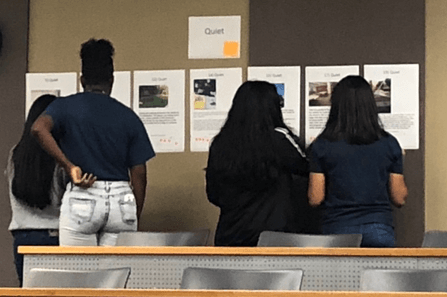
Hello, EvaluATE! We are Ouen Hunter (student at the Interdisciplinary Ph.D. in Evaluation, IDPE), Emma Perk (co-PI of EvaluATE at The Evaluation Center), and Michael Harnar (assistant professor at the IDPE) from Western Michigan University. We recently used PhotoVoice in our evaluation of a Michigan-based Upward Bound (UB) program (a college preparation program focused on 14- to 19-year-old youth living in low-income families in which neither parent has a bachelor’s degree).
PhotoVoice is a method of inquiry that engages participants in creating photographs and short captions in response to specific prompts. The photos and captions provide contextually grounded insights that might otherwise be unreachable by those not living that experience. We opted to use PhotoVoice because the photos and narratives could provide insights into participants’ perspectives that cannot be captured using close-ended questionnaires.
We created two prompts, in the form of questions, and introduced PhotoVoice in person with the UB student participants (see the instructional handout below). Students used their cell phones to take one photo per prompt. For confidentiality reasons, we also asked the students to avoid taking pictures of human faces. Students were asked to write a two- to three-sentence caption for each photo. The caption was to include a short description of the photo, what was happening in the photo, and the reason for taking the photo.

PhotoVoice participation was part of the UB summer programming and overseen by the UB staff. Participants had two weeks to complete the tasks. After receiving the photographs and captions, we analyzed them using MAXQDA 2018. We coded the pictures and the narratives using an inductive thematic approach.
After the preliminary analysis, we then went back to our student participants to see if our themes resonated with them. Each photo and caption was printed on a large sheet of paper (see figure 2 below) and posted on the wall. During a gallery walk, students were asked to review each photo and caption combination and to indicate whether they agree or disagree with our theme selections (see figure 3). We gave participants stickers and asked them to place the stickers in either the “agree” or “disagree” section on the bottom of each poster. After the gallery walk, we discussed the participants’ ratings to understand their photos and write-ups better.


Using the participants’ insights, we finalized the analysis, created a webpage, and developed a two-page report for the program staff. To learn more about our reporting process, see our next blog. Below is a diagram of the activities that we completed during the evaluation.

The PhotoVoice activity provided us with rich insights that we would not have received from the survey that was previously used. The UB student participants enjoyed learning about and being a part of the evaluation process. The program staff valued the reports and insights the method provided. The exclusion of faces in the photographs enabled us to avoid having to obtain parental permission to release the photos for use in the evaluation and by UB staff. Having the students use cell phone cameras kept costs low. Overall, the evaluation activity went over well with the group, and we plan to continue using PhotoVoice in the future.

Except where noted, all content on this website is licensed under a Creative Commons Attribution-NonCommercial-ShareAlike 4.0 International License.







 EvaluATE is supported by the National Science Foundation under grant numbers 0802245, 1204683, 1600992, and 1841783. Any opinions, findings, and conclusions or recommendations expressed on this site are those of the authors and do not necessarily reflect the views of the National Science Foundation.
EvaluATE is supported by the National Science Foundation under grant numbers 0802245, 1204683, 1600992, and 1841783. Any opinions, findings, and conclusions or recommendations expressed on this site are those of the authors and do not necessarily reflect the views of the National Science Foundation.